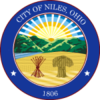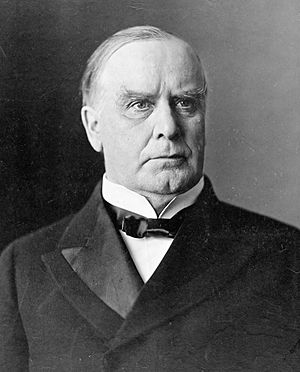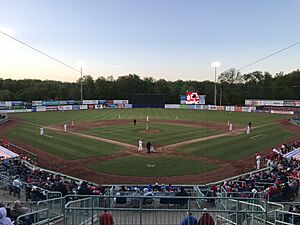Niles, Ohio facts for kids
Quick facts for kids
Niles, Ohio
|
||
|---|---|---|
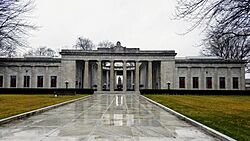
|
||
|
||
| Motto(s):
"An Ohio City with a Proud Past and a Vision for the Future"
|
||
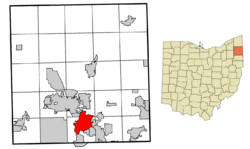
Location of Niles in Trumbull County, Ohio
|
||
| Country | United States | |
| State | Ohio | |
| County | Trumbull | |
| Established | 1806 | |
| Named for | Hezekiah Niles | |
| Area | ||
| • Total | 8.60 sq mi (22.28 km2) | |
| • Land | 8.59 sq mi (22.24 km2) | |
| • Water | 0.02 sq mi (0.04 km2) | |
| Elevation | 899 ft (274 m) | |
| Population
(2020)
|
||
| • Total | 18,443 | |
| • Density | 2,147.78/sq mi (829.27/km2) | |
| Time zone | UTC−5 (Eastern (EST)) | |
| • Summer (DST) | UTC−4 (EDT) | |
| ZIP code |
44446
|
|
| Area code | 330, 234 | |
| FIPS code | 39-55916 | |
| GNIS feature ID | 2395235 | |
Niles is a city in Ohio, located in Trumbull County. In 2020, about 18,443 people lived there. Niles is part of the Youngstown–Warren area. It is found where the Mahoning River meets Mosquito Creek.
Niles is famous as the birthplace of William McKinley. He was the 25th President of the United States. The city's early economy focused on making iron. Later, it also produced steel and glass. After heavy industries declined in the 1970s, Niles became a major shopping area. This growth happened around the Eastwood Mall and along U.S. Route 422. The Mahoning Valley Scrappers baseball team plays in Niles at Eastwood Field.
Contents
History of Niles
Niles was started in 1806 by James Heaton. He owned one of Ohio's first iron-making factories. The town was first called Heaton's Furnace. Later, it was renamed Nilestown after Hezekiah Niles. He was the editor of a newspaper called Niles Register in Baltimore. In 1843, the name was shortened to Niles.
In the early 1800s, Heaton built a forge and a blast furnace. These were located near what is now the city's central park. Heaton is known for making the first bar iron in Ohio. The iron industry in Niles grew until the late 1800s. Then, an economic depression in 1873 caused the biggest factory, James Ward and Company, to close.
By the early 1900s, Niles had new companies. These included Ohio Galvanizing and the Niles Glass Works of General Electric. Between 1900 and 1920, the city's population grew from 7,468 to over 13,000 people.
Floods and Challenges
In 1913, Niles faced a big challenge. Heavy rain and melting snow caused massive floods across Ohio. On Easter Sunday, March 23, 1913, the Mahoning River flooded Niles. This caused a lot of damage and many people were affected. The floods caused over $3 million in damage.
Niles is well-known as the birthplace of William McKinley. He was the 25th President of the United States. McKinley was born in Niles on January 29, 1843. He went to Niles High School, which was later renamed Niles McKinley High School.
After President McKinley was assassinated in 1901, people in northeastern Ohio were very sad. In 1915, Youngstown businessman Joseph G. Butler, Jr. helped build the National McKinley Birthplace Memorial. This memorial is in downtown Niles. Today, it has the community's library and a small museum.
Community Growth and Tensions
Because Niles was in the Mahoning Valley, a center for steel production, many immigrants came to the city in the early 1900s. These newcomers were mostly from Southern and Eastern Europe. After World War I, there were some tensions between different groups in many northern U.S. cities. Niles also saw some of these challenges.
In the 1920s, a group called the Ku Klux Klan tried to march in Niles. This was because Niles had a large Catholic population. There were some difficult times and disagreements in the city. Eventually, the city had to bring in help to restore order.
In the 1970s, Niles' economy faced problems. The steel industry in the Mahoning Valley declined. After this, the community faced another natural disaster.
1985 Tornado Impact
On May 31, 1985, a very strong tornado hit Niles. This tornado started west of Newton Falls and moved through Lordstown and Warren. When it reached Niles, it caused a lot of damage. It destroyed buildings and many homes. The tornado also went through the city's historic Union Cemetery.
In the Niles area, nine people lost their lives, and 250 were injured. Nearly 70 homes were completely destroyed. Another 65 to 70 homes were badly damaged. Across the Mahoning and Shenango valleys, 25 people died. There was about $140 million in property damage. Interestingly, a large gorilla statue, which was an advertisement for a store, was one of the few things left standing in one damaged area. A tornado in 1947 had taken a very similar path through Niles.
Geography of Niles
Niles covers a total area of about 8.63 square miles (22.35 square kilometers). Most of this area, about 8.61 square miles (22.30 square kilometers), is land. A small part, about 0.02 square miles (0.05 square kilometers), is water.
Population and People
| Historical population | |||
|---|---|---|---|
| Census | Pop. | %± | |
| 1880 | 3,879 | — | |
| 1890 | 4,280 | 10.3% | |
| 1900 | 7,468 | 74.5% | |
| 1910 | 8,361 | 12.0% | |
| 1920 | 13,080 | 56.4% | |
| 1930 | 16,314 | 24.7% | |
| 1940 | 16,273 | −0.3% | |
| 1950 | 16,773 | 3.1% | |
| 1960 | 19,545 | 16.5% | |
| 1970 | 21,581 | 10.4% | |
| 1980 | 23,072 | 6.9% | |
| 1990 | 21,128 | −8.4% | |
| 2000 | 20,932 | −0.9% | |
| 2010 | 19,266 | −8.0% | |
| 2020 | 18,443 | −4.3% | |
| 2021 (est.) | 18,367 | −4.7% | |
| Sources: | |||
Niles is known for having a diverse population. It has a large Italian-American community. The main place for Italian-American culture is Our Lady of Mount Carmel Catholic Church. Their yearly festival in July is a well-known Italian-American celebration in Ohio.
2010 Census Information
In 2010, there were 19,266 people living in Niles. There were 8,499 households and 4,971 families. The city had about 2,237 people per square mile (864 per square kilometer).
Most residents, 93.1%, were White. About 3.5% were African American. Other groups made up smaller percentages. About 1.3% of the population was Hispanic or Latino.
About 26.1% of households had children under 18. The average household had 2.24 people. The average family had 2.88 people. The median age in the city was 42 years old.
Economy of Niles
Niles is a suburb between Warren and northern Youngstown. It is one of the main shopping areas in the Mahoning Valley. Most of the city's businesses are located around U.S. Route 422.
The Eastwood Mall opened in 1969. It has over 100 stores and restaurants. The mall is part of a larger shopping area called the Eastwood Mall Complex. This complex includes many outdoor shopping centers. The Cafaro Company, which developed the mall, moved its main office to Niles in 2016.
Arts and Culture in Niles
The National McKinley Birthplace Memorial Library and Museum is in downtown Niles. It was built in 1915 to honor President William McKinley. The Ward-Thomas Museum is home to the Niles Historical Society. Eastwood Field, where the MLB Draft League team Mahoning Valley Scrappers play, opened in Niles in 1999.
Sports in Niles
| Club | League | Venue | Established | Championships |
|---|---|---|---|---|
| Mahoning Valley Scrappers | MLB Draft League | Eastwood Field | 1999 | 1 |
The Mahoning Valley Scrappers are a minor league baseball team. They moved to Niles in 1999. The team plays at Eastwood Field. This stadium is located behind the Eastwood Mall on U.S. Highway 422.
Several boxers have fought in Niles. Youngstown-based boxer Kelly Pavlik had a nationally televised fight in Niles in 2003. He won by knockout. Another boxer from Youngstown, Harry Arroyo, fought and won four professional fights in Niles between 1980 and 1982. He later became a world champion.
Education in Niles
Children in Niles go to schools in the Niles City School District. The schools serving Niles are:
- Niles Primary School – for grades K-2
- Niles Intermediate School – for grades 3-5
- Niles Middle School – for grades 6-8
- Niles McKinley High School – for grades 9-12
Notable People from Niles
Many interesting people have come from Niles, Ohio. Here are a few:
- Joseph Bangust (1915–1941) – A World War II naval hero.
- George Burns (1893–1978) – A major league baseball player who won an MVP award.
- Jim Capuzzi (born 1932) – A professional football player for the Green Bay Packers.
- William McKinley (1843–1901) – The 25th President of the United States.
- Kenneth Patchen (1911–1972) – A famous poet.
- Tim Ryan (born 1973) – A U.S. Representative for Ohio.
- Dominic Sena (born 1949) – A director of films and music videos.
- Harry M. Stevens (1855–1934) – Known for his work at ballparks and said to have invented the hot dog.
See also
In Spanish: Niles (Ohio) para niños


